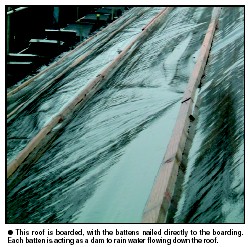
There are times when all the tiles or slates on a pitched roof need to
be removed to allow repairs or alterations to be undertaken to the roof
structure or sub-structure.
Between stripping off the roof covering and
putting it back on again, may be as little as one week or perhaps as
long as a year. The anticipated time period between stripping and
reinstatement will decide the choice of temporary roof covering.Duration
If the time period of exposure is short, say less than one month, it is
quite normal and acceptable to use normal underlay. If the period of
exposure is greater than one month but less than six months, tarpaulins
would be more appropriate. In excess of six months it would be more
appropriate to use corrugated iron sheets or similar materials. If the
total roof structure is to be modified or if the building below the roof
is sensitive to water ingress, such as a hospital or a museum, then it
may be more appropriate to install a total scaffold over-roof with
enclosed sides.
With each of these options there are
considerations to be taken into account at the planning and construction
stage, to ensure that the roof functions properly.
Short duration
Exposed underlay, depending upon its manufacture, has a limited
life. Many of the polyester and polythene based underlays have
restrictions on the maximum period that the material should be exposed
to ultraviolet light. Like most plastics, sunlight will affect the
durability of the material and given sufficient time will cause it to
disintegrate. In the short term the material can shrink with
temperature. Initial shrinkage is a reaction to the material being held
in tension while being coiled into rolls to stop it creasing. Some
underlay materials can shrink with heat like shrink wrap, while others
are more stable. Under high wind suction loads, some underlay materials
can be stretched sufficiently to make them flap. Generally, bituminous
underlays do not shrink or stretch as much as plastic-based underlays.
However, hessian reinforced underlay is more prone to tearing under wind
flapping conditions.
Traditional timber rafters
To overcome the effects of wind disturbance it is normal to lay the
underlay with a sag and temporary batten at the laps and midspan of each
sheet. The sag allows rainwater to drain under the temporary battens,
while the battens hold the underlay on the roof under windy conditions.
With underlays that will shrink, an excessive sag may be advisable to
ensure that after shrinkage the underlay is not taut. In some instances
the underlay can shrink sufficiently to develop horizontal corrugations
that will hold water rather than dissipate it.
Boarded roofs
If the roof is boarded, such that it is not possible to lay the
underlay with a sag, then the underlay should either be laid on counter
battens or held down with counter battens. If temporary tile battens are
laid horizontally to hold the underlay down, each batten will act as a
dam to rain water draining down the roof slope. Water will always take
the easiest route to the earth, therefore if it is trapped it will seep
between the batten and the underlay. If the underlay shrinks and
stretches, the holes in the underlay - formed by the batten fixing nails
- will become elongated and oversize sufficient to let water seeping
between the battens and the underlay to track down the nail into the
roof below.
|
 |
| By fixing the
battens vertically they will not act as a dam and will hold the underlay
down tight. With horizontal bands of underlay the total height of the roof
slope will need to be unrolled
together and the counter battens installed as work proceeds across the
roof. Alternatively the underlay could be installed vertically with
vertical battens fixed over the laps. Water leakage down nail holes is
less of a problem with bituminous underlay as a little heat causes the
bitumen to melt and seal around the nail hole.
Longer duration
The installation of tarpaulins is similar to that of underlay with the
addition of rope anchorages and a material that is more robust and will
be removed prior to roofing work commencing. In place of temporary tile
battens scaffold boards are frequently used.
The use of corrugated sheeting will require
larger sized temporary battens (minimum 38x38mm) to be nailed to the
rafters at centres to suite the corrugated iron sheets to allow the
sheets to be correctly nailed to the battens. The most difficult parts
to weather will be the junctions with other features and roof slopes;
this is generally done with metal sheet trims. In some instances the
corrugated sheets could be retained as a rigid underlay for the final
construction. But in most instances these will be removed prior to
roofing work commencing.
Scaffold over roof
If a total over-roof is used this will provide the greatest
protection to the building. However it is less convenient for the
roofer. The height of the temporary roof above the existing roof needs
to be sufficient to allow men to stand upright safely. Delivering and
manoeuvring materials about the roof can be more difficult, especially
where materials are craned into position. It can be very dark under the
temporary roof and some form of lighting may be needed. All flue pipes
discharging noxious gasses need to be temporarily diverted or turned off
to ensure roofers are not overcome or made ill from the fumes. This
applies to domestic heating systems, soil pipes and fume extracts from
laboratories and production processes. There is also the risk that
damage will be inflicted on the new roof covering during the dismantling
of the temporary roof.
Conclusion
- A temporary roof needs to keep out all
of the elements, just like a conventional tiled or slated roof.
- Some underlays deteriorate, shrink and
stretch under heat, sun and wind conditions. Check with the
manufacturers.
- Vertical counter battens are not as
easy to install as horizontal battens, and do not act as a dam to
water.
- The safety of tradesmen on a roof
should be paramount
|
| Compiled by Chris Thomas, The Tiled
Roofing Consultancy, 2 Ridlands Grove, Limpsfield Chart, Oxted, Surrey,
RH8 0ST, tel 01883 724774 |